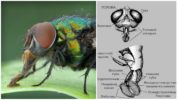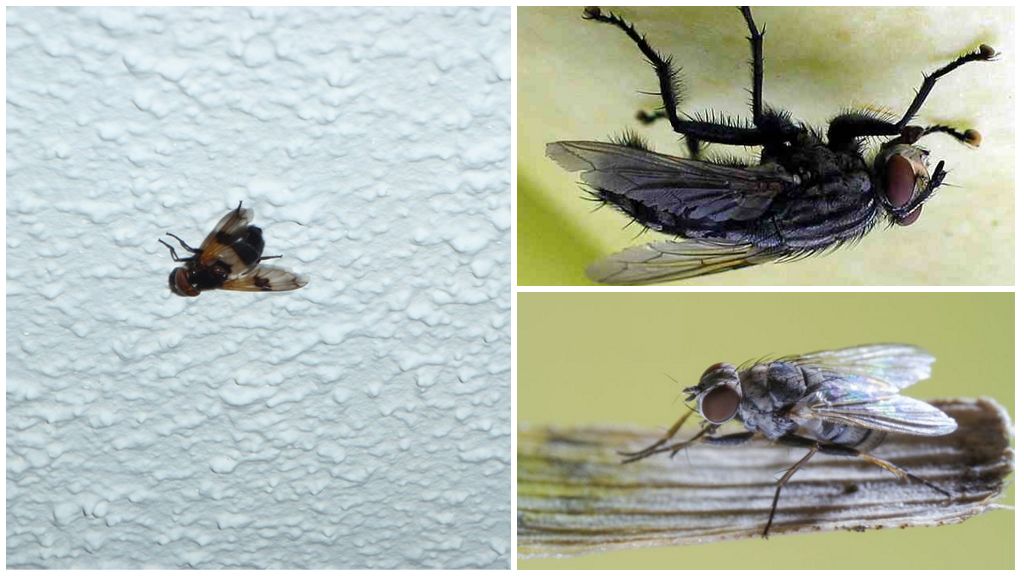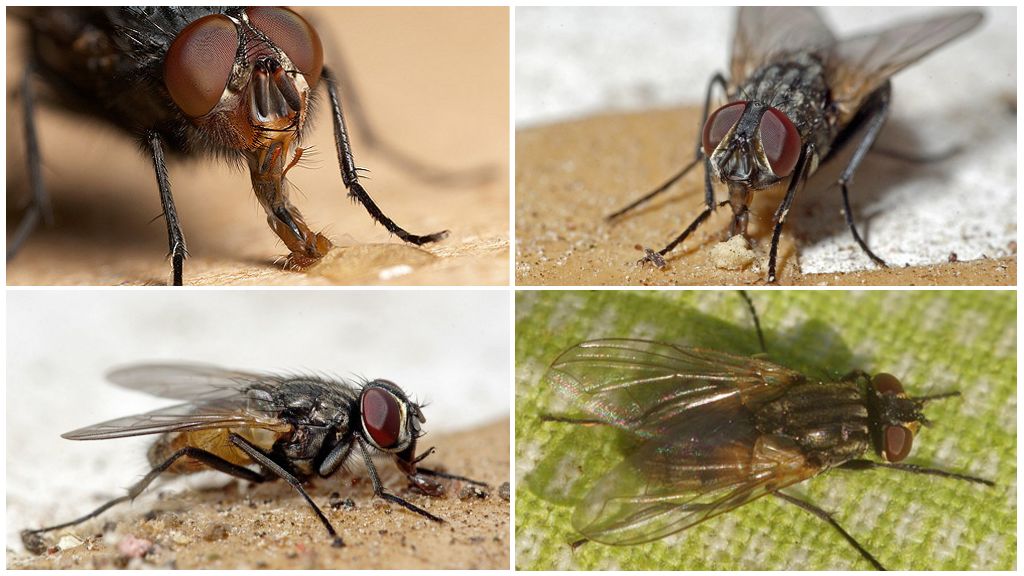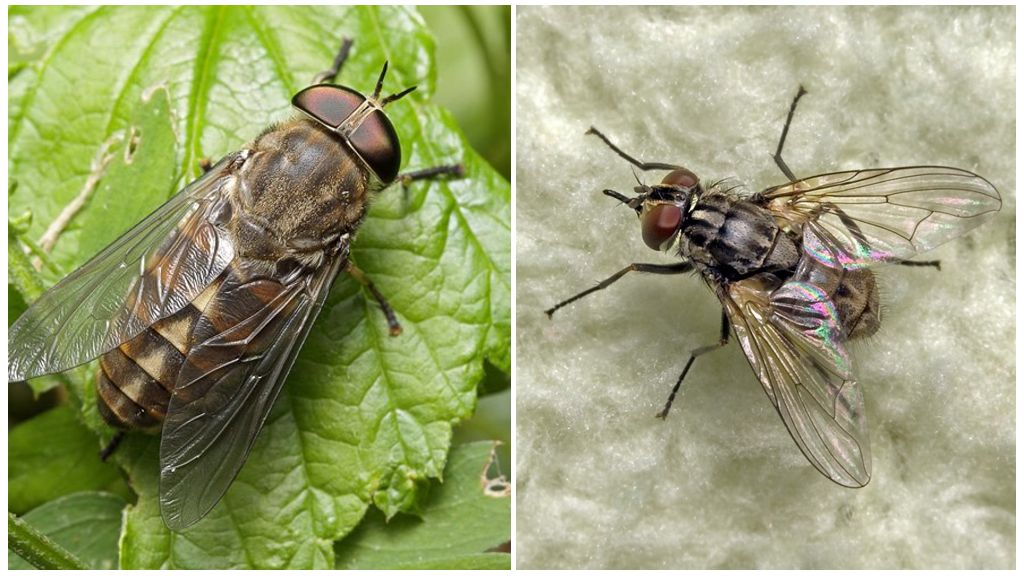- The structure of the head of a fly
- Fly structure
The structure of the fly is simple in appearance, but if you begin to understand it, it is very complex. Insects are the subject of research in many scientific centers, institutes, the secret of some of their abilities has not yet been disclosed. How much does a fly weigh - a frequently asked question. The elastic abdomen is able to stretch during pregnancy, nutrition, so the weight changes and differs in females, males.
Fly anatomy - external structure
The general plan of the structure of dipterans, the skeleton of a fly is the same as that of other insects - head, chest, abdomen. On the head is the oral apparatus, antennas, eyes. The chest consists of three segments, with a pair of transparent wings, three pairs of legs. The space in the chest is filled with powerful muscles. The abdomen includes most of the digestive organs, the reproductive system.
On a note!
Flies have pronounced sexual dimorphism, when the appearance and structure of the female is different from the male.
Fly head
Includes organs of vision, nutrition, hearing.
- The oral apparatus. Regardless differences in the nutrition of many species of flies, their oral apparatus is represented by a proboscis of a sucking, licking type. A pair of extended blades of the upper, lower lip is in contact with food. The jaws of the fly are powerful. Numerous tubules converge into the proboscis of a fly, at its central point. The mouth apparatus of the fly, which feeds on blood, is additionally equipped with hard, sharp scales that perform the function of teeth, help pierce the skin of an animal, a person. The fluid is drawn into the head using a pharyngeal pump.
- The eyes occupy most of the head. Make up complex system, which was taken as the basis for the development of a modern photo camera. They consist of many simple eyes that look outside like a facet mesh. The insect receives a comprehensive, but mosaic image of objects. Each eye includes several hundred, thousand facets. The housefly has about 4 thousand. Many species have 3 simple eyes located on the crown of the head. This structure allows you to instantly capture the movement, but does not give a complete picture of the image.
- Tendrils. Peculiar antennas function as a guide. They help to smell, determine the direction of movement. In the process of evolution, they changed, there are differences in males, females.
Interesting!
Males always have larger eyes than females. That allows them to respond faster to movement, it is better to assess the environment. Females have a more developed sense of smell, with the help of which it finds a favorable environment for laying eggs.

Chest
It consists of three segments - antero-, mid-, and posterior chest. The bones of the fly and the bulk of the muscles provide flight, so the middle part is the most developed. How many legs does a fly have - 3 pairs. Each consists of 5 parts, has its own powerful muscles. The structure of the paws of the fly is completed by claws, suction cups, which allow the insect to stay on a vertical, horizontal surface, and even upside down. When walking soft pads are compressed, a sticky secret is secreted. This feature helps the flies to hold and mix freely on the window pane and smooth surface.
On a note!
The paws are one of the main senses - the sense of smell.Paws the insect determines the taste of food, analyzes the quality. After a few seconds of analysis, it starts feeding or flies away.
Wings of a fly
Upper well developed, transparent, webbed. The posterior pair is deformed into the appendages - the hummer. Maintain balance in flight, allow you to hang in the air, and also make a buzzing sound. Thin wings are reinforced with cylindrical veins.
Interesting!
In the process flight an insect can turn off one or the other wing, change its trajectory dramatically, performs complex maneuvers, breaks down without preliminary dispersal. The structure and ability of the insect was taken as the basis for many flying structures in airplanes, helicopters.
Abdomen
It has a cylindrical shape, elongated, consists of 10 segments, includes the organs of a fly, responsible for reproduction, respiration, nutrition and other important functions. The elastic chitinous cover expands with food intake during pregnancy. Therefore, the weight of the fly varies depending on these conditions.
Interesting!
Plain home or indoor fly weighs 12 mg, during pregnancy, the mass increases to 15 mg. Up to the same indicator, weight can increase after a meal. The male is smaller, weighs about 12 mg. About 80 of these insects fit in one gram.
The face of a fly can be easily examined under a microscope, but when carefully examined with the naked eye, an elongated oral apparatus is visible, large eyes are green, red, yellow, brown, blue. The ears of a fly are located on different parts of the body, helping to capture air vibrations, ultrasound.
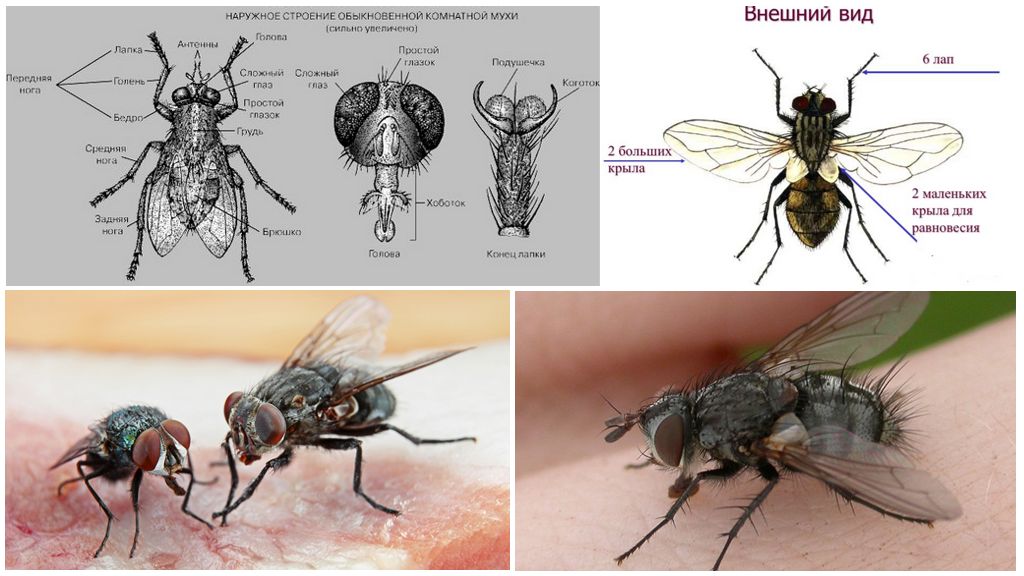
Internal structure
How does a fly breathe, can it think if it has a memory and other questions often interest an ordinary person who has repeatedly encountered pests.
Reproductive system
The internal genital organs are located in the abdomen, consist of testes in males, ova in females, adnexal glands, ducts. The shape of the external appendages in different species of dipterans is different. The structure of special “captures” in males is the only clear sign of the difference between the genus. At one time, a female housefly lays from 70 to 150 eggs, depending on the species. Among meat (cadaver) flies there are live-bearing species. They reproduce maggots in the same large amount.
Digestive system
In the abdomen, most of the digestive organs are located - the intestines, goiter, malpighian vessels, which remove the tubules. As such, there is no digestive organ, food is digested from the outside, enters the goiter in a ready-made form. Before the food is absorbed, the fly initially secrets a secret, which digests the food.
Other organs, systems
The brain of a fly is represented by many nerve plexuses located in different parts of the body. There is no such complex system as in humans. The brain plays a major role in coordinating insect behavior, but a completely different organ is responsible for the reflexes - the reflex arc. The tiny brain consists of hundreds of thousands of neurons and, despite the apparent simplicity of the structure, allows flies to do incredible tricks.
On a note!
The nervous system and brain allow insects to determine the right direction of movement in the opposite direction from danger in fractions of a millisecond. There is enough memory for only 3 seconds, there is no intelligence in its full understanding.
The circulatory system is represented by the aorta, pterygoid muscle, spinal vessel, heart. However, the heart of a fly has an extremely simple structure, does not fulfill the functions that a person has, animals. The blood of a fly is yellowish or colorless. Its main function is the transfer of nutrients. It does not participate in the saturation of organs with oxygen, does not contain red blood cells.
The respiratory system is represented by many tracheas throughout the body. Opens out with the help of spiracles. Tracheas branch into numerous capillaries and have a complex structure.They deliver oxygen directly to various organs, tissues. 10 pairs of spiracles, 2 pairs on the chest, the rest on the abdomen.
